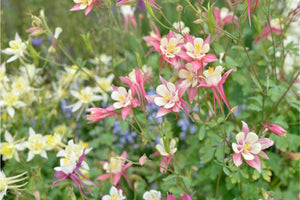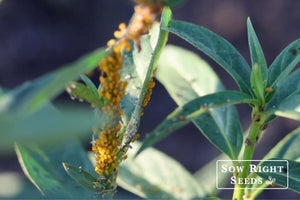Powdery Mildew Prevention and Treatment Tips to the Rescue!
DiseasesDo the leaves on your squash plants look like someone sprinkled talcum powder on them? It could be the all-too-common powdery mildew. But don’t lose hope. You can save your plants with a basic understanding of what powdery mildew is, how it spreads, and how to prevent it.

What is Powdery Mildew?
Powdery mildew is a fungal disease characterized by white to grayish powdery growth on the surface of leaves, stems, and sometimes flowers. It is caused by various species of powdery mildew fungi. These fungi thrive in warm, humid environments, often becoming more prevalent in late summer.
Powdery Mildew Signs and Symptoms
Powdery mildew is easily recognizable by its signature symptom: a powdery, white-to-gray fungal growth that appears predominantly on the upper surface of leaves. This dust-like mildew can also be found on the undersides of leaves, stems, flowers, buds, and occasionally fruit.
If you catch it early, you’ll see what looks like white or gray powder on the leaves. Once the leaves are more heavily infected, the leaves may turn yellow or brown. Severe infections can lead to distorted leaves that wither and fall off prematurely.
The fungal growth invades the plant cells without killing them but sapping the strength and vitality needed for healthy plant growth.

How Does Powdery Mildew Spread?
Powdery mildew is a fungal disease that spreads through the production and dissemination of microscopic spores known as conidia. These spores, which are produced in vast numbers, can be transported by the wind, insects, animals, and even garden tools to nearby plants.
Conditions that encourage this spread are typically dry foliage surfaces, warm temperatures, and shaded areas with poor air movement. PennState Extension explains it as high humidity at night and low humidity during the day with temperatures between 70 and 80ºF.
The humidity and warmth provide the right environment for fungus growth, and the drier air allows the spores to blow and spread. It's important to note that, unlike many other fungal spores, powdery mildew does not require water to germinate and infect plants. Human activities such as pruning or handling can inadvertently aid its spread by shaking free the spores from an infected plant to a healthy one.

How to Prevent Powdery Mildew:
Powdery mildew is everywhere. It’s not worth sterilizing your garden to eradicate it completely. But you can practice wise gardening techniques to keep it in check.
1 - Provide Enough Airflow
Spacing your plants far enough apart to allow sufficient room and airflow is the first step. As the plants grow, you can prune away excess leaves. Check frequently and remove any leaves with spots of mildew. Trellising can also improve airflow. Growing plants up a trellis will keep leaves off the ground and give them more access to light and air.
2 - Water Effectively
Avoid overhead watering, as it can create a more humid environment, encouraging mildew to grow. Instead, use drip hoses and watering methods that focus on getting water to the roots. Applying mulch can also keep the soil moist.
3 - Use Appropriate Garden Sanitation
Remove infected leaves as soon as possible. Put them into a bag to reduce the spread of spores. Always clean your pruning tools between plants. You can carry a cotton swab with isopropyl alcohol with you to sanitize your tools as you work.
Check your garden frequently, especially the plants that are more susceptible to powdery mildew. If you catch it when the first spores start to grow, you can more easily control its growth.
Steps to Control Powdery Mildew:
Once you’ve spotted the signs of mildew, there are things you can do to slow down the growth and spread.
1 - Remove leaves.
First, remove the affected leaves. Place them in a bucket or bag as you work in the garden so you don’t carry them around and drop spores onto other plants.
2 - Improve airflow.
Once you’ve removed the affected leaves, look for leaves you could prune. If there are too many leaves overlapping each other, you can remove them.
3 - Change the pH of the leaves.
Using homemade sprays can temporarily change the pH of plant leaves. This will make the surface too acidic or too alkaline for the mildew spores to grow.
It’s important to remember that you can’t completely eradicate powdery mildew. A healthy garden environment is a mixture of all kinds of spores and microorganisms. But you can reduce mildew spread and keep it from completely destroying your crops.

Common Home Remedies for Powdery Mildew
There are several common remedies for controlling powdery mildew. As with most gardening advice, every gardener is a little different and has their favorites. These are some of the most popular approaches for mildew control. Each of these remedies attempts to change the pH on the surface of the leaves. This creates an environment that stops fungus from growing.
Milk Spray:
Mix whole milk with water in a 40:60 ratio and spray it on the affected leaves. Milk's antiseptic properties could help manage mildew. Milk spray should be applied once a week. Some gardeners don’t like the sour milk smell, while others don’t even notice it. When using this method, spray it on the leaves on a sunny day so it can dry quickly.
Baking Soda Solution:
Combine 1 tablespoon of baking soda, 1/2 teaspoon of liquid soap, and a gallon of water. Spray the concoction onto the plant surfaces to create an unfavorable pH for the mildew to thrive.
Garlic Extract:
Garlic has natural fungicidal properties. Crush several cloves of garlic, steep in water, strain, and then spray this solution onto plant leaves.
Vinegar Solution:
Use a mixture of vinegar (apple cider vinegar works well) and water at a ratio of 3 tablespoons of vinegar to a gallon of water to spray down infected plants. The acetic acid in the vinegar acts as a fungicide.
Neem Oil:
Neem oil has multiple gardening benefits, including acting as a fungicide. Mix it as directed on the product label and spray on the infected plants.
Remember that when using treatments, it's important to test a small area first to ensure the solution does not negatively affect the plant. Additionally, application should be done during cooler parts of the day, typically early morning or late afternoon, to minimize leaf burn and plant stress.
Susceptible Vegetables and Flowers
Powdery mildew is a widespread fungal disease that can affect a wide variety of plants. According to the University of Minnesota Extension , over 10,000 plants are affected by powdery mildew fungi. While many species can harbor powdery mildew fungi, certain vegetables and flowers are notably more susceptible.
Vegetables like cucumbers, pumpkins, squash, and beans often fall prey to infected leaves caused by fungal growth. These plants frequently display powdery spots, primarily due to the ample leaf surface area that creates an ideal environment for powdery mildew infection, especially in the high-humidity conditions of late summer when spore production is rampant.
Among flowers, roses and zinnias are particularly prone to this fungal disease. With their dense, lush foliage, healthy plants can quickly become infected if environmental conditions favor the growth of powdery mildew. Also, delicate ornamentals such as phlox and begonias are more susceptible to this affliction.

Powdery Mildew FAQs
How do I treat powdery mildew?
Start treating powdery mildew as soon as you see any signs of the disease. Remove infected leaves, increase airflow, and apply sprays that stop the fungal growth by changing the pH on the surface of the leaves.
What triggers powdery mildew?
Warm, humid conditions provide the perfect conditions for powdery mildew spores to grow.
Can plants recover from powdery mildew?
If powdery mildew is caught and stopped early, plants can recover.
Is powdery mildew harmful?
Powdery mildew becomes harmful when allowed to grow and affects the whole plant. Eventually, the leaves won’t be able to photosynthesize, and the plant will die.
Whether you're dealing with ornamental plants or a wide range of vegetables, powdery mildew fungi do not discriminate. They thrive in many environmental conditions, especially in late summer.
But there's good news! There are ways to prevent and treat powdery mildew. Remember, not every spot of mildew will result in the demise of your garden. With proper care and timely action, your garden can still produce a healthy harvest.
Written by Beverly Laudie






Leave a comment